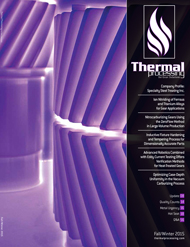
When was vacuum carburizing introduced?
The process has been around since the 1960s. Vacuum carburizing enables more precise control of case depth and microstructure than conventional gas carburizing. The process is repeatable without the need for ancillary items such as endo generators, gas analyzers, and in-situ oxygen probes. This enables customers not familiar with conventional carburizers to install stand-alone systems that can be used for “just-in-time” production needs without all the additional equipment or expertise of operating a conventional carburizer, as vacuum furnaces are operated more like a recipe-driven CNC.
Who were the early players in technology development?
C.I. Hayes provided some of the original furnaces for the process, which started to change carburizing. In the early process, carburizing was done at higher furnace pressures (600-mb range), which caused high levels of soot. This had a negative impact on the process for a long time. In late 1990s, ECM’s patented Infracarb process made the process more robust, and ECM continued developing vacuum carburizing into the mainstream high-volume production process it is today.
Who were early users of vacuum carburizing?
Early on, many companies in the U.S. tried the process and moved back to conventional carburizing. ECM worked closely with auto manufacturers in France to develop a high-volume system on the basis of the shorter cycle time of the process that was needed to produce the required case depth on manual-transmission parts. The first known high-volume furnace was a two-cell vertical system installed in France in 1991 with gas quenching in a separate cell. Two additional vertical furnaces were installed, one in 1992 and one in 1993 with four cells each. This was the beginning of high-volume systems with internal automation and high-pressure gas quenching. After several years, manufacturers in the U.S. caught on, quickly implementing vacuum carburizing in major automotive programs for five- and six-gear automatic transmissions along with driveline components starting in 1999 and 2000.
What are the benefits of vacuum carburizing compared with conventional gas carburizing?
Vacuum carburizing systems are safe. Cold-wall construction, small footprints, and the absence of flame curtains make it possible to start and stop the furnace as needed, and systems are clean using high-pressure nitrogen and helium. Processes can be shortened due to potential higher carburizing temperatures and increased carbon potentials available. Lower gas consumption and ease of use are big factors in justifying using these systems along with consistent results load after load, year after year in multiple heating cells. Consistent, higher quality metallurgical results are seen in higher uniformity of case depth from pitch to root line in gears.
Who are the major players in continuing technology and equipment development?
There are several companies continually vying for projects. Each company appears to be searching for the right niche — commercial heat treaters, aerospace, automotive, marine, energy, and other markets. ECM has been providing research-based equipment and processes for all of these markets for more than 20 years with more than 1,000 heating cells installed worldwide. Vacuum carburizing technology has not changed a great deal other than researching different gases with certain patent rights. Research and development has always been a mainstay at ECM in carburizing, vacuum equipment design for ease of operation, maintenance, and especially in the area of gas quenching.
What areas of vacuum carburizing require more R&D?
Low distortion is most commonly associated with vacuum carburizing. There is more work required in integrating quenching technologies that have a low distortion effect on the process. Steel suppliers have done a great job over the past 10 years developing new materials for gas quenching and helping customers understand quenchability. However, large cross-sectional parts still need to be oil-quenched in most cases and still undergo low distortion. With the precision in case depth and metallurgical properties that vacuum carburizing offers, along with more uniform quenching, the process will expand into markets that require deep case depths in larger parts, providing the benefits that the automotive and aerospace markets realize today.
What is the potential for further growth?
New applications will emerge as conventional carburizing users learn more about vacuum carburizing. Many gains have been made over the past 10 years with hundreds of cells being installed and thousands of parts per hour being processed that were never thought possible before. Larger loads, and in some cases, smaller loads, are on the horizon to help the technology become the main carburizing technology for the future. Also, the ease of use and maintenance of a vacuum carburizing system compared with a conventional system has swayed many decisions to move production into vacuum carburizing.
How does ECM fit into this picture?
ECM has been a leader in this market for the past 20 years and expects to remain a leader with equipment, maintenance, and gas-quench designs at the forefront of its R&D efforts. The key with any customer is to reduce risk with the implementation of any new product or process. ECM excels in this process with simulation, testing, distortion results, estimated production costs, reduced floorplans, and proven high uptime of installed equipment, which allows customers to focus on other areas of its new product launches and rely on the equipment for a repeatable process.




























